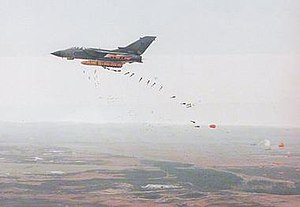JP233
| JP233 | |
|---|---|

JP233 deployed from a Panavia Tornado
|
|
| Type | Submunition delivery system |
| Place of origin | United Kingdom |
| Service history | |
| Used by |
Royal Air Force Royal Saudi Air Force |
| Wars | Operation Desert Storm |
| Production history | |
| Manufacturer | Hunting Engineering |
| Specifications | |
| Crew | Two (Panavia Tornado aircrew) |
|
|
|
| Filling | 30 SG-357 cratering bomblets 215 HB-876 anti-personnel mines |
| Filling weight | SG-357, 57 lb (26 kg) HB-876, 5.3 lb (2.4 kg) |
Originally known as the LAAAS (Low-Altitude Airfield Attack System), the JP233 was a British submunition delivery system consisting of large dispenser pods carrying several hundred submunitions designed to attack runways.
Development of the system began in 1977 as a 50/50 cooperative program between the U.S. Air Force and Hunting Engineering (now known as INSYS) of the UK. The USAF intended to use the weapon with its FB-111 strike aircraft; however, in 1982 rising costs forced them to pull out of the program, and the British completed development on their own for potential use with the Tornado, Jaguar and Harrier.
The dispensers could be carried on wing pylons: short-finned containers for bomblets, or medium-length finned containers for mines. The F-111 was capable of carrying a pair of each type, but the Jaguar and Harrier would be able to carry only a single pair of either type. However, the Tornado could be fitted with a pair of much larger pods on the shoulder pylons, each containing both types of munition. Each JP233 as fitted to the Tornado was divided into a rear section with 30 SG-357 runway cratering submunitions, while the front section carried 215 HB-876 anti-personnel mines. Both types of submunitions were retarded by small parachutes.
The SG-357, which weighed 26 kilograms (57 pounds), was a two-stage munition. The longer, smaller-diameter forward section consists of a cylindrical high-explosive charge with a hole down the centre. The shorter, larger-diameter rear section held a shaped charge. At the front of the munition was a telescopic stand-off fusing system that created the correct detonation distance for the shaped charge. On impact, the extended fuse initiated the shaped charge, creating a molten metal jet which travelled through the centre of the forward charge element and then penetrated the concrete runway surface to create an underground chamber. The momentum of the cylindrical charge was enough for it to follow down through the hole created by the shaped charge before exploding some distance under the runway surface. This second explosion was intended to produce a crater with significant "heave" at the edge, making repairs much more difficult and time-consuming.
...
Wikipedia
